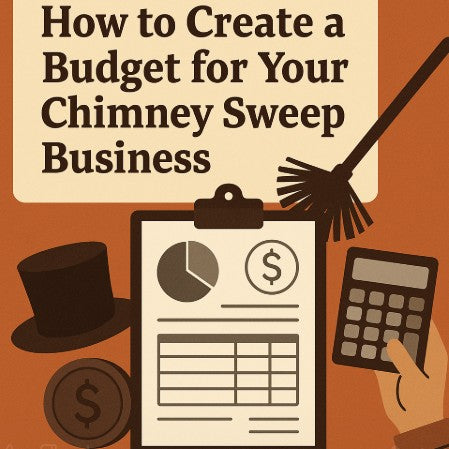How to Create a Budget for Your Chimney Sweep Business

Running a chimney sweep business takes grit, hustle, and a lot of climbing—literally and figuratively. But if you want your business to be more than just a busy season hustle, you’ve got to get one thing dialed in: your budget. In a previous article, we discussed the importance of a budget but this article highlights the process for creating one.
Now, don’t worry—this doesn’t mean you need to become an accountant. Creating a budget for your chimney business is more about planning smart than crunching numbers all day. Think of it like laying out your gear before a job: if you’re prepared, everything runs smoother.
Here’s a simple, step-by-step guide to building a solid budget that works for your chimney sweep business.
Step 1: Start with Your Income
Ask yourself: Where does the money come from?
List all the ways your business brings in revenue, like:
- Standard chimney cleanings
- Water proofing
- Level 2 inspections
- Chimney caps, liners, or repairs
- Masonry work
- Dryer vent cleanings
- Service agreements or annual plans
Use past months (or last year’s numbers, if you’ve got them) to estimate how much you expect to make each month. If your business is seasonal, note the busy and slow months to get a clear picture of cash flow.
💡 Pro tip: Overestimate your expenses and slightly underestimate your income to stay on the safe side.
Step 2: List Your Fixed Expenses
These are the costs that stay mostly the same each month, no matter how many jobs you book. Common fixed expenses for a chimney sweep might include:
- Truck/van leases
- Insurance (business liability, vehicle, workers’ comp)
- Office/shop rent or storage unit
- Business software (scheduling, accounting, CRM)
- Phone and internet
- Uniforms or branded gear
- Depreciation associated with your assets
Add these up so you know what you have to cover each month just to keep the lights on.
Step 3: Estimate Your Variable Expenses
Now think about the costs that go up or down depending on how busy you are. These include:
- Gas and vehicle maintenance
- Job supplies and material costs (brushes, vac bags, drop cloths, camera maintenance)
- Part-time labor or subcontractors
- Credit card fees or payment processing
- Tools and equipment replacements
These numbers might change each month, so make your best estimate based on your past jobs.
Step 4: Don’t Forget the Irregular Costs
These are the “every once in a while” expenses that can sneak up on you:
- Certifications or CE training
- Advertising (flyers, Google Ads, seasonal mailers)
- Safety gear upgrades
- Website hosting or redesign
- Equipment purchases
You don’t want to be blindsided—build some of these into your budget monthly, even if you’re just setting aside money for when they pop up.
Step 5: Map It All Out
Now you’ve got two key pieces:
- Your projected income (money coming in)
- Your expected expenses (money going out)
Subtract expenses from income to see your estimated profit each month. If you’re in the negative, that’s a red flag—you may need to cut some costs, raise your prices, or plan ahead to get through slower months.
You can track all of this with:
- A simple spreadsheet
- Free accounting software like Wave
- Paid options like QuickBooks or Jobber if you want more features
Step 6: Check In Monthly
Your budget isn’t a “set it and forget it” tool. Check in every month to see how your actual numbers compare to your estimates:
- Did you spend more on fuel this month?
- Did you bring in fewer inspection jobs than expected?
- Was a promo you ran worth it?
The more you tweak your budget, the more accurate (and helpful) it becomes.
Bonus: Build in a Safety Net
Try to set aside a little each month for slow seasons or emergencies—a broken ladder, stolen tools, or a dead van battery can derail things if you’re not prepared.
Having a cushion in place lets you breathe a little easier when something unexpected comes up.
Final Sweep
You don’t need a finance degree to run a profitable chimney business—you just need a plan. A budget helps you stay ahead, make smarter decisions, and build a business that lasts beyond the next busy season.
Take an afternoon, go through these steps, and give your business the structure it deserves. Your future self (and your bottom line) will thank you.


